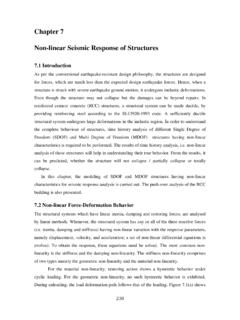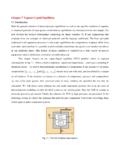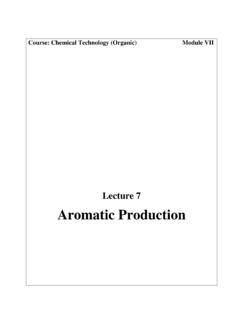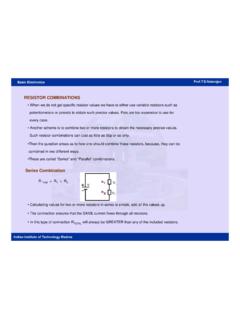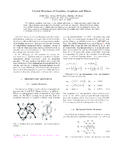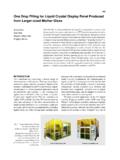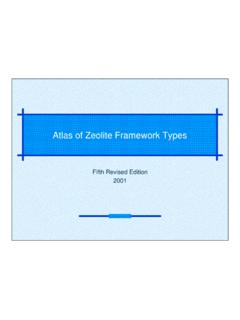Transcription of Material Science - NPTEL
1 Material Science Prof. Satish V. Kailas Associate Professor Dept. of Mechanical Engineering, Indian Institute of Science , Bangalore 560012. India Chapter 2. Atomic Structure, Interatomic Bonding and Structure of Crystalline Solids Atomic Structure and Atomic Bonding in Solids Atomic Structure Atoms are composed of electrons, protons, and neutrons. Electrons and protons are negative and positive charged particles respectively. The magnitude of each charged particle in an atom is 10-19 Coulombs. The mass of the electron is negligible with respect to those of the proton and the neutron, which form the nucleus of the atom. The unit of mass is an atomic mass unit (amu) =. 10-27 kg, and equals 1/12 the mass of a carbon atom. The Carbon nucleus has Z=6, and A=6, where Z is the number of protons, and A the number of neutrons. Neutrons and protons have very similar masses, roughly equal to 1 amu each.
2 A neutral atom has the same number of electrons and protons, Z. A mol is the amount of matter that has a mass in grams equal to the atomic mass in amu of the atoms. Thus, a mole of carbon has a mass of 12 grams. The number of atoms in a mole is called the Avogadro number, Nav = 1023. Note that Nav = 1 gram/1 amu. Calculating n, the number of atoms per cm3 of a Material of density (g/cm3): . n = N av M. where M is the atomic mass in amu (grams per mol). Thus, for graphite (carbon) with a density = g/cm3, M =12, we get 6 1023 atoms/mol g/cm3 / 12 g/mol) = 9 . 1022 C atoms/cm3. For a molecular solid like ice, one uses the molecular mass, M(H2O) = 18. With a density of 1 g/cm3, one obtains n = 1022 H2O molecules/cm3. Note that since the water molecule contains 3 atoms, this is equivalent to 1022 atoms/cm3. Most solids have atomic densities around 6 1022 atoms/cm3.
3 The cube root of that number gives the number of atoms per centimeter, about 39 million. The mean distance between atoms is the inverse of that, or nm. This is an important number that gives the scale of atomic structures in solids. Atomic bonding in solids In order to understand the why materials behave like they do and why they differ in properties, it is necessary that one should look at atomic level. The study primarily concentrates on two issues: what made the atoms to cluster together, and how atoms are arranged. As mentioned in earlier chapter, atoms are bound to each other by number of bonds. These inter-atomic bonds are primarily of two kinds: Primary bonds and Secondary bonds. Ionic, Covalent and Metallic bonds are relatively very strong, and grouped as primary bonds, whereas van der Waals and hydrogen bonds are relatively weak, and termed as secondary bonds.
4 Metals and Ceramics are entirely held together by primary bonds - the ionic and covalent bonds in ceramics, and the metallic and covalent bonds in metals. Although much weaker than primary bonds, secondary bonds are still very important. They provide the links between polymer molecules in polyethylene (and other polymers) which make them solids. Without them, water would boil at -80 C, and life as we know it on earth would not exist. Ionic Bonding: This bond exists between two atoms when one of the atoms is negative (has an extra electron) and another is positive (has lost an electron). Then there is a strong, direct Coulomb attraction. Basically ionic bonds are non-directional in nature. An example is NaCl. In the molecule, there are more electrons around Cl, forming Cl- and fewer electrons around Na, forming Na+. Ionic bonds are the strongest bonds.
5 In real solids, ionic bonding is usually exists along with covalent bonding. Na Cl Schematic representation of ioning bonding. Here, Na is giving an electron to Cl to have stable structure Covalent Bonding: In covalent bonding, electrons are shared between the atoms, to saturate the valency. The simplest example is the H2 molecule, where the electrons spend more time in between the nuclei of two atoms than outside, thus producing bonding. Covalent bonds are stereo-specific each bond is between a specific pair of atoms, which share a pair of electrons (of opposite magnetic spins). Typically, covalent bonds are very strong, and directional in nature. The hardness of diamond is a result of the fact that each carbon atom is covalently bonded with four neighboring atoms, and each neighbor is bonded with an equal number of atoms to form a rigid three-dimensional structure.
6 H H. Figure 2. Schematic representation of covalent bond in Hydrogen molecule (sharing of electrons). Metallic Bonding: Metals are characterized by high thermal and electrical conductivities. Thus, neither covalent nor ionic bondings are realized because both types of bonding localize the valence electrons and preclude conduction. However, strong bonding does occur in metals. The valence electrons of metals also are delocalized. Thus metallic bonding can be viewed as metal containing a periodic structure of positive ions surrounded by a sea of delocalized electrons. The attraction between the two provides the bond, which is non-directional. Electron cloud from the valence electrons M M M M. M M M M Core M M M M. M M M M. Figure 3. Metallic bonding Fluctuating Induced Dipole Bonds: Since the electrons may be on one side of the atom or the other, a dipole is formed: the + nucleus at the center, and the electron outside.
7 Since the electron moves, the dipole fluctuates. This fluctuation in atom A produces a fluctuating electric field that is felt by the electrons of an adjacent atom, B. Atom B then polarizes so that its outer electrons are on the side of the atom closest to the + side (or opposite to the side) of the dipole in A. Polar Molecule-Induced Dipole Bonds: Another type of secondary bond exists with asymmetric molecules, also called polar molecules because of positively and negatively charged regions. A permanent dipole moment arises from net positive and negative charges that are respectively associated with the hydrogen and chlorine ends of the HCl molecule, leading to bonding. The magnitude of this bond will be greater than for fluctuating induced dipoles. Figure 4. Dipole bond in water These two kinds of bonds are also called van der Waals bonds.
8 Third type of secondary bond is the hydrogen bond. It is categorized separately because it produces the strongest forces of attraction in this category. Permanent Dipole Bonds / Hydrogen bonding: It occurs between molecules as covalently bonded hydrogen atoms for example C-H, O-H, F-H share single electron with other atom essentially resulting in positively charged proton that is not shielded any electrons. This highly positively charged end of the molecule is capable of strong attractive force with the negative end of an adjacent molecule. The properties of water are influenced significantly by the hydrogen bonds/bridges. The bridges are of sufficient strength, and as a consequence water has the highest melting point of any molecule of its size. Likewise, its heat of vaporization is very high. crystal Structures, Crystalline and Non-Crystalline materials crystal structures All metals, a major fraction of ceramics, and certain polymers acquire crystalline form when solidify, in solid state atoms self-organize to form crystals.
9 Crystals possess a long-range order of atomic arrangement through repeated periodicity at regular intervals in three dimensions of space. When the solid is not crystalline, it is called amorphous. Examples of crystalline solids are metals, diamond and other precious stones, ice, graphite. Examples of amorphous solids are glass, amorphous carbon (a-C), amorphous Si, most plastics. There is very large number of different crystal structures all having long-range atomic order; these vary from relatively simple structures for metals to exceedingly complex structures for ceramics and some polymers. To discuss crystalline structures it is useful to consider atoms as being hard spheres, with well-defined radii. In this scheme, the shortest distance between two like atoms is one diameter. In this context, use of terms lattice and unit cell will be handy.
10 Lattice is used to represent a three-dimensional periodic array of points coinciding with atom positions. Unit cell is smallest repeatable entity that can be used to completely represent a crystal structure. Thus it can be considered that a unit cell is the building block of the crystal structure and defines the crystal structure by virtue of its geometry and the atom positions within. Important properties of the unit cells are The type of atoms and their radii R. Cell dimensions (Lattice spacing a, b and c) in terms of R and Angle between the axis , , . a*, b*, c* - lattice distances in reciprocal lattice , *, *, * - angle in reciprocal lattice n, number of atoms per unit cell. For an atom that is shared with m adjacent unit cells, we only count a fraction of the atom, 1/m. CN, the coordination number, which is the number of closest neighbors to which an atom is bonded.
